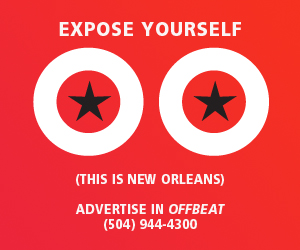Armstrong Park is still not where it could be. It contains the birthplace of New Orleans music: Congo Square, arguably the most sacred music-related site in this city.
Armstrong Park—once part of the vibrant Treme neighborhood— was created in the 1960s when the city decided to build the Pontchartrain Expressway by leveling Claiborne Avenue, ultimately destroying the street, one of the most important streets in New Orleans’ African-American neighborhoods.
The park’s high, rather intimidating iron fence has often been criticized for destroying the openness of the public park and has been a source of controversy since the park was constructed, as well as the parking which some advocates say should be green space.
Armstrong Park also is the site of Municipal Auditorium, long the go-to venue for most all of the city’s Mardi Gras balls.
But the Mardi Gras balls moved to the Rivergate Center (now the site of Harrah’s Casino) and then to the Ernest N. Morial Convention Center (ironically, Harrah’s set up shop in the Auditorium before it moved to its current location in the former Rivergate) .
Post-Katrina, the Municipal Auditorium has sat vacant and crumbling (it was severely damaged by Katrina floodwaters) with no imminent plans to restore it. Stuart Juneau tried to solicit support for a revamp of the Municipal Auditorium to contain a jazz museum, a home for the New Orleans Jazz Orchestra, more performance space, a distribution center for concert equipment, and office space. The concept never took hold.
A few years back, the New Orleans Jazz & Heritage Foundation had the idea to create some highly successful community festivals in Armstrong Park (the original Jazz Fest took place in Armstrong Park), and other events have been created to attract locals back to the park (I’ve found that there’s still an inherent fear of Armstrong Park as being too crime-ridden to be safe to visit). And then there’s the Jazz in the Park series, which has drawn music lovers to the part on Thursdays in the spring and fall.
For years, WWOZ was located in one of the small buildings near the St. Phillip Street/North Rampart corner of Armstrong Park. They moved to their current location in the French Market post-Katrina. The National Park Service was supposed to renovate the other historic properties, but there apparently wasn’t enough money to restore the properties, and they have since been abandoned.
The Mahalia Jackson Performing Arts Centre is also located in the park and makes use of the large parking areas adjacent for performances in the Mahalia Jackson.
A few years ago there was a proposal to create a Levitt Pavilion in the park, but the city’s agreement with the management company controls the parking contract forced the Levitt representatives to look elsewhere for a site.
The Congo Square Preservation Society was set up to preserve and promote the historic nature of the park. The Society holds drum circles there every Sunday.
The point of all this explanation is to speculate why–with the obvious importance of the park historically, culturally and geographically—there’s no manager of Armstrong Park to coordinate activities and events, and serve as an advocate for the park. Armstrong Park and Congo Square are at the heart of New Orleans music. It’s a pity that the City hasn’t designated a fully-dedicated person in a leadership capacity to take care of the park and its activities, to market it and create more opportunities to showcase this legendary area (currently activities in the park are handled by the New Orleans Parks & Parkways). Armstrong Park has become a political football over many mayoral administrations. The city appears to have a deep financial interest in the park, yet it has not appointed a leadership person to care for the park. And because the park has so many sensitive touchpoints, particularly as it related to the African American community, perhaps the city has just stepped back as to not engender more controversy amongst the African-American community vis a vis the park.
Surely, it’s time to create an official commission with knowledgeable leadership that can result in the betterment of Armstrong Park for the entire New Orleans community; who can work with the disparate groups that have an interest in the history and culture of the park. That means preserving its heritage and finding ways to be more inclusive of all residents, keep it safe, and help to develop and promote it in a sensitive manner, while at the same time to create ways to create revenue to sustain and market the park so that it is more widely perceived as the heart of the music of the city.
What do you think should be done with the management of Armstrong Park?
Take our poll and get a chance to win two tickets to see The Head & The Heart + Declan McKenna at the Civic Theater on October 26.




